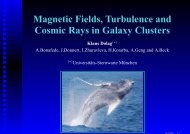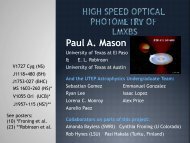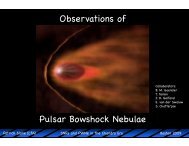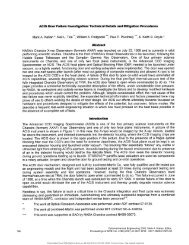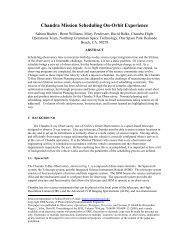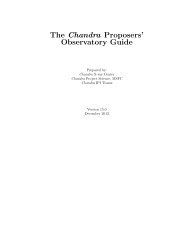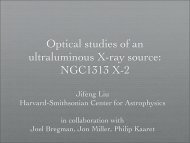observational overview of state transitions in x-ray binaries
observational overview of state transitions in x-ray binaries
observational overview of state transitions in x-ray binaries
You also want an ePaper? Increase the reach of your titles
YUMPU automatically turns print PDFs into web optimized ePapers that Google loves.
No Compact Jet<br />
(<strong>in</strong>teraction with<br />
ISM)<br />
Fender, Belloni, Gallo 2004<br />
Fender, Homan, Belloni, 2009<br />
s<strong>of</strong>t<br />
Ejection<br />
Events<br />
rms-drop<br />
type-B QPOs<br />
JETS<br />
Compact<br />
Jet Switches on<br />
(radio)<br />
Radio<br />
Flare<br />
hard<br />
Compact<br />
Jet Weakens<br />
(radio/nIR)<br />
Compact<br />
Jet<br />
Compact<br />
Jet Switches on<br />
(nIR)<br />
Homan et al. 2005<br />
Russell et al. 2006<br />
Coriat et al. 2009<br />
I’m go<strong>in</strong>g to use the same schematic aga<strong>in</strong> and will summarize the picture that is emerg<strong>in</strong>g<br />
from various radio and nIR papers. I’ll start with the hard <strong>state</strong> and progress through the<br />
diagram <strong>in</strong> an anti-clockwise manner. The hard <strong>state</strong> gives rise to steady radio emission from<br />
a compact jet. Radio and nIR emission scale <strong>in</strong> similar ways with the X-<strong>ray</strong> lum<strong>in</strong>osity. Once a<br />
system turns the corner the radio and nIR start to weaken, suggest<strong>in</strong>g the jet is gett<strong>in</strong>g less<br />
powerful. Than at some po<strong>in</strong>t dur<strong>in</strong>g the transition a radio flare is observed, which is thought<br />
to be the result <strong>of</strong> an ejection event. Interest<strong>in</strong>gly, this flare always seems to take place with<strong>in</strong><br />
a few days <strong>of</strong> this zone with odd variability properties that I just discussed. In sources that<br />
cross this zone multple times dur<strong>in</strong>g an outburst, like XTE J1858+226, we see radio flares<br />
associated with rms drops <strong>in</strong> all cases. Bright sources that enter the steep power law <strong>state</strong><br />
suggest that ejection events cont<strong>in</strong>ue to occur <strong>in</strong> that <strong>state</strong>.<br />
No radio emission from the central source is seen <strong>in</strong> the s<strong>of</strong>t <strong>state</strong>. If there is radio emission it<br />
is likely the result <strong>of</strong> <strong>in</strong>teraction <strong>of</strong> the jet ejecta with the ISM.<br />
At some po<strong>in</strong>t the source starts it return to the hard <strong>state</strong>. We’re not exactly sure when the<br />
jet switches on aga<strong>in</strong> <strong>in</strong> the radio, but from at least one source it is clear that it start<br />
somewhere halfway <strong>in</strong> the transition, and perhaps even earlier. In the near-<strong>in</strong>frared jet<br />
emission only becomes significant when it reaches the hard <strong>state</strong>.





